Characteristics of bimetallic radiators: the pros and cons
Bimetallic products appeared relatively recently, but gained wide popularity among buyers and gained a reputation as one of the most durable and durable options.
In this review, we will talk about all the main features of this type of radiators and touch upon both the advantages and disadvantages so that you can understand the topic thoroughly and when making a decision were guided by objective facts, and not by subjective opinions and questionable advice.
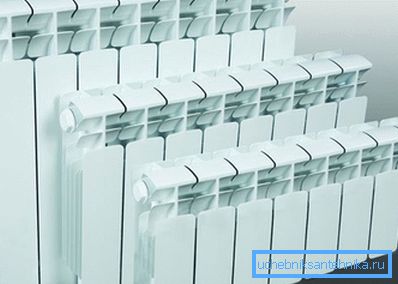
Pros and cons of products
All the advantages and disadvantages of bimetallic radiators due to the peculiarities of their design and technological process of production. The most important advantages of experts consider the following factors:
| Reliability | The design is able to withstand a pressure of 30-40 bar, so it is almost not afraid of water hammer and high pressure. It is for this reason that you can use this product group in urban apartments, where pressure drops can be significant, which leads to the failure of other options. |
| Durability | In quality designs, the service life is 40 years or more, for less reliable options, the indicator is more modest - about 20 years, but it is also a rather impressive indicator. It is important to follow the elementary rules of service and flush the system no rage every three years. |
| Efficiency | Due to the fact that the volume of a bimetallic radiator is small, it takes much less energy to heat the coolant. At the same time, work efficiency is very high and not inferior, and more often exceeds the performance of other analogues. |
| Easy installation | If you wish, you can do the installation work with your own hands, everything is very simple. You do not need special tools and skills of professional plumber, installation instructions that come with the radiator, will allow you to easily understand the features of the process |
Note! Of course, not to mention the attractive appearance of the products, such radiators look modern and stylish and organically fit into almost any situation, durable wear-resistant coating protects the surface.
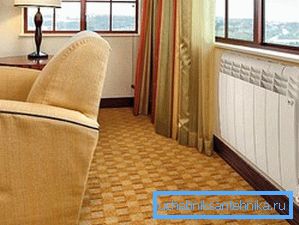
As for the shortcomings, they are also available:
- The minus, which is the most significant is the high price, this factor is the reason that the bimetal did not take a leading position in the market. On the other hand, high-quality products have always been expensive, because their production spends much more resources and time.
- The steel core provides strength, but is poorly resistant to corrosion, which can form when there is no liquid inside (summer prophylaxis in electrical networks or airing of individual elements), and antifreeze is not recommended in such constructions.
- A small cross section of vertical channels can cause their clogging, if the quality of the coolant is low, which is not uncommon in centralized systems, this will significantly reduce the efficiency of the design.
Tip! In order to eliminate corrosion processes under any conditions for the longest possible term, we recommend choosing options in which the internal elements are made of stainless steel, this material is able to withstand even chemical effects without compromising reliability.
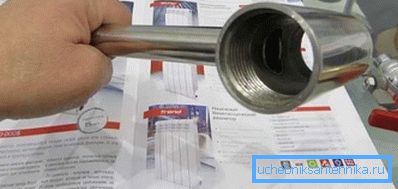
All important features of bimetallic radiators
To begin with we will analyze the design of products, then we will consider the main operating indicators. All the information below is relevant only for quality products, cheap Asian options are unlikely to meet these criteria.
Design
Any product of this type consists of the following elements:
- The outer part is made of high-strength aluminum alloy and is a system of fins that transfer heat to the room, and are also responsible for the convection process. The configuration of the ribs was developed by heating engineers and is designed to ensure maximum efficiency of each element.
- Internal channels consist of metal pipes, which give the system strength and rigidity, as well as exclude contact of aluminum with the coolant, which eliminates its corrosion. This option is implemented in bimetallic radiators.
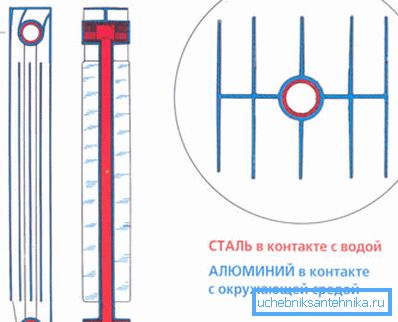
- More low-end solutions are also found on the market - polibimetallic radiators, their main feature is that they are reinforced with a metal tube only in vertical cavities, and the horizontal channels are not closed by anything. This option is not very well suited for apartments, as a poor-quality coolant will very quickly begin to destroy aluminum.
Specifications
Now consider the technical characteristics and dimensions of bimetallic radiators:
- Heat output of one section may vary depending on its size., but for average options, this figure is 160-200 watts, which is evidence of high efficiency products.
- The design is able to withstand high enough pressure, therefore, it can be used in virtually any system without fear. After all, even the figures given by the manufacturer are given with a margin, in fact, the radiator is even more reliable. If you need a particularly durable option, then choose solid products, they are able to withstand pressure and 100 Bar.
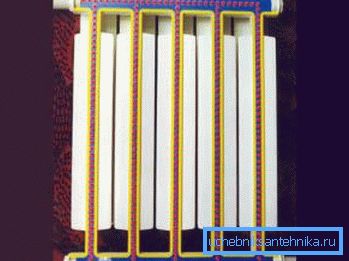
- Center distance indicates the location of horizontal cavities., The standard values are 200, 300, 350, 500 and 800 mm, but if you need a larger version, you can find vertical structures with distances up to 180 mm. To find out the actual height, you must add 70-80 mm (depending on the manufacturer) to each of these indicators.
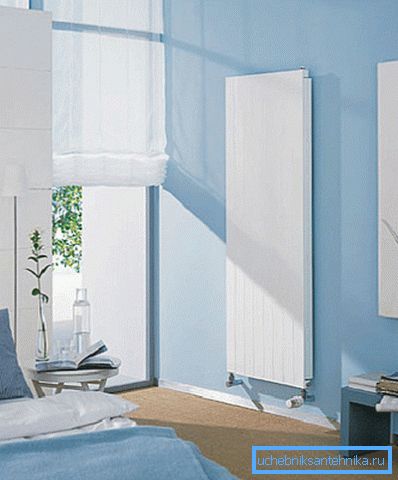
- The capacity of the sections depends on the height, but for standard variants the values are as follows: the spacing of 200 mm - 100-160 g, 350 mm - 150-200 g, 500 mm - 200-300 g. As you can see, the liquid holds very little, so the heating happens quickly, and it consumes much less energy. For example, a 500 mm radiator from 10 sections can hold from 2 to 3 liters of water, the same is included in two sections of a battery made of cast iron.

- Now let's deal with the width and depth of each element, if the height can vary, then these values are always the same.A: width is 80 mm and depth is 80-85. Based on this, you are planning how many edges will be installed in a particular space and how much they will protrude (remember that there should be at least 300 mm from the wall to the radiator and 50 mm should be better).

- Note that polibimetallic products have improved heat transfer (approximately 10%), and their cost is 20% lower.. This option can be considered for use in private homes, where the quality of the coolant is better.
Defining the dimensions of bimetallic radiators you need, remember that the top and bottom need to leave a space of 100 mm in size, it is impossible to place the structure close to the floor or to the sill, as this will greatly worsen its efficiency.
Conclusion
Bimetallic radiators can be called one of the best on the market, and if it were not for the high price, then this option would hardly have full-fledged competitors. It is important to choose a quality option and take into account all the parameters that affect the performance, the video in this article will help you understand the topic even better.